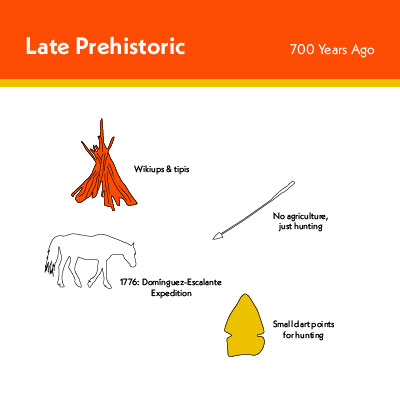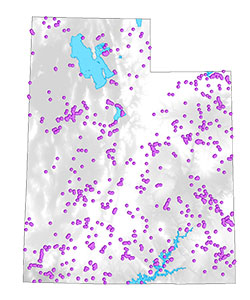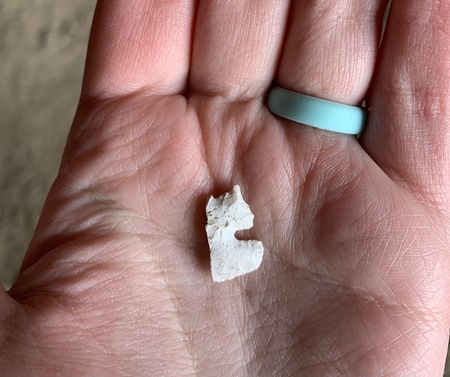By Savanna Agardy
1250 AD — 1776 AD / 1847 AD
Late Prehistoric Life

The Late Prehistoric period lasted from 1250 AD to the 1700s, which is when western European and European American settlers began entering Utah. During this time, five different cultural groups called Utah their home: the Goshute, Paiute, Shoshone, Navajo, and Ute. Today, there are eight Native Nations in Utah that originate from these five cultures.
During this time period, Native peoples lived more mobile lifestyles than the Fremont and Ancestral Puebloans. Each group adapted to their local environment by hunting and gathering seasonal foods, while some groups continued to farm corn, such as Navajos and Paiutes. People no longer lived in pithouses or pueblos like those of the Fremont and Ancestral Puebloan periods. Different groups used various dwellings, depending on their local environments. Shoshone and Ute people used tipis. In desert areas, people built wickiups and hogans.

European explorers and settlers from Spain, France, and Great Britain arrived on the North American continent in the 1500s and 1600s. Europeans brought with them new diseases, animals, and technologies that resulted in many changes to Native American lifestyles.
Many Native Americans died because they did not have immunity to the newly introduced European diseases. Sadly, European diseases spread along trade routes and infected Native Americans before the first Europeans arrived in Utah. These diseases killed millions of Native Americans, which resulted in dramatic changes to their cultures and ways of living.
Europeans also brought horses to the Americas. Horses spread across the land ahead of Europeans, coming into contact with Native Americans long before Europeans did. Because of this, many Native American tribes like the Ute, Shoshone, and Navajo began using horses. This allowed people to travel farther distances in a shorter amount of time, which changed how they gathered food and interacted with other people.

New technologies, like metal, were also introduced to Native Americans through trade. This allowed them to make metal tools and weapons, which were not commonly available before Europeans came to the continent. Native American tribes changed dramatically as they adopted new animals, technologies, and other practices during this time.
Ending the Late Prehistoric Period
Archaeologists mark the end of the Late Prehistoric Period with the arrival of European settlers in the area. In Utah, this began around the time of the American Revolution. The Spanish colonies in New Mexico began trading with Ute people in the 1750s. By the 1770s, Spanish explorers and traders from Santa Fe began traveling through Utah, trading with Navajo and Ute people.
More Europeans came into northern Utah in the early 1800s, and the number of settlers grew quickly after the migration of members of the Church of Jesus Christ of Latter-day Saints began in 1847. This influx of people from Europe, America, and even Asia continued into the 1900s. Learn more about the Historic Period.
Global migration and settlement in Utah disrupted traditional lifeways for Native Americans, as newcomers began to take important resources like food and water. This ushered in a period of struggle, creative adaptation, and resilience for Native people, who found ways to preserve their cultures and communities in a deeply changed world. Native Americans still live vibrant lifestyles in Utah today. Learn more about Utah tribes.
Keep Exploring!
Return to the Archaeology page here.
Return to the I Love Utah History home page here.